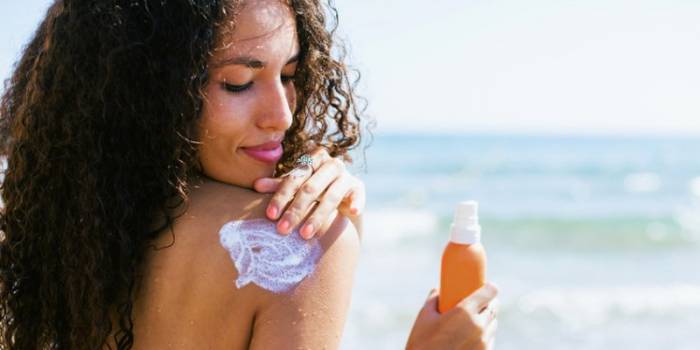I’ve learned in my medical and dermatology training—and from what I witness every day in my practice—just how much sun exposure contributes to skin cancers and photoaging (meaning, premature aging that happens to your skin from repeated exposure to UV radiation). In fact, about 90 percent of the most common types of skin cancer (basal cell carcinoma and squamous cell carcinoma) can be directly attributed to UV exposure, and so can an estimated 90 percent of skin aging.
Most people, however, fall somewhere in the middle of the spectrum, wanting to guard their skin from the sun, but perhaps not really knowing what products and strategies offer the best protection. They’ll grab something with SPF on the label, smear it on occasionally, and hope for the best. The problem is, not all sun protection products and practices are created equally, which could lead to a false sense of security—and you may wind up burned, sun-damaged, or even facing a skin cancer at some point. Here are seven things you shouldn’t solely rely on to keep your skin completely safe this summer.
1. Supplements claiming to help protect skin from the sun.
These may sound like an easy way to protect the skin, but they haven’t been proven to be safe and effective as methods of sun protection—something that the Food and Drug Association (FDA) recently warned consumers about in a press announcement. In a statement from FDA commissioner Scott Gottlieb, M.D., the organization said that the marketing of four supplement products in particular (Advanced Skin Brightening Formula, Sunsafe Rx, Solaricare, and Sunergetic) was “putting people’s health at risk by giving consumers a false sense of security that a dietary supplement could prevent sunburn, reduce early skin aging caused by the sun, or protect from the risks of skin cancer.”
It’s worth noting that the companies apparently have updated the product claims since the FDA warning letter, and the language called out by the FDA has been adjusted or omitted. The available information about these items does not outright describe the supplements as comparable to sunscreen, or something that should take the place of sunblock. But some do still make arguably lofty, vague claims (for instance, one product claims to provide “continuous protection across every inch of your skin at all times,” which could still give someone a false sense of security, in my opinion)—and I wouldn’t count on them alone.
This isn’t to say that certain vitamins may not have some value. A 2015 study in the New England Journal of Medicine showed that vitamin B3 (nicotinamide) may lower the risk of non-melanoma skin cancers in those with a history of carcinoma, and polypodium leucotomos, a fern extract, may have antioxidant properties beneficial to the skin after sun exposure, according to a few smallstudies. But these types of supplements are better considered possible complements to other proven forms of sun protection, not replacements for them.
A better idea: Stick to what’s been proven to help keep your skin safe and healthy: Seek shade, avoid peak sun hours, slip into UPF 50+ clothing and hats (some of my favorite brands, to come), and apply broad-spectrum SPF 30+ sunscreen to exposed areas before going outside.
2. A base layer of sunscreen that you applied at home, before heading to the beach.
Broad-spectrum SPF 30+ formulas protect for only about two hours—or less if you’ve been swimming or sweating, according to the American Academy of Dermatology (AAD). Frequent reapplications are the key to sun-safe skin. And keep in mind that this is two hours from the time you put it on—not two hours from the time you step into the sun. So if you put your sunscreen on at home, then drove an hour to the beach, then grabbed some lunch on the way, it may be time for another application before you even plop down in your beach chair.
A better idea: Swipe or spray on a new layer of sunscreen at regular intervals if you’re going to be exposed throughout the day. (Even dermatologists acknowledge that sunscreen isn’t always convenient, but then again, neither are brushing and flossing.)
3. That random bottle of sunscreen you found in the back of your closet, in your beach bag from last year, or in the bottom of your car.
Heat and sunlight can break down UV-filtering ingredients. The kinds that guard against UVA-light like avobenzone tend to break down fastest, but all sunscreen ingredients do degrade with light and heat. Sunscreens last longer and work best if they are stored in a cool, shady spot, like in your beach bag or cooler. And if you dug up a bottle from the back of your closet or an old beach bag, make sure to check the date on it. The FDA regulates sunscreens as drugs, and most are labelled with an expiration date. If yours is past its prime, there’s no guarantee it will provide the level of protection listed on the bottle.
A better idea: Make sure to refresh your sunscreen supply regularly (the average person should go through at least a few bottles each summer for everyday activities), and pay attention to the expiration dates. When you’re done using your SPF, stash it in a cool location, like in your cooler, under a beach towel, or inside your house.
4. Your makeup that boasts SPF 30.
The SPF sprinkled into foundations and BB creams can offer bonus protection. But unless you apply makeup with a trowel, then re-apply it every two hours, it won’t be enough to guard against sun damage effectively.
The amount of protection we get from a product varies widely based on the SPF number, texture, thickness, and how much we wear. This rule applies to sunscreen, too: If you apply a thin layer of sunblock, you may not be getting the full SPF level listed on the bottle. Most adults only apply one quarter to one half of the recommended amount of sunscreen when they put it on, according to the AAD. For that same reason, you shouldn’t rely on the SPF you’re getting when you put on your foundation.
A better idea: Rub on a broad-spectrum SPF 30+ sunscreen (or a daily moisturizer spiked with broad-spectrum SPF 30+) every morning, followed by makeup or whatever else you like to wear on top. And if you're going to be in the sun for a prolonged time, like at a rooftop happy hour, you’ll need to reapply at regular intervals.
I realize some people may be worried about messing with their makeup by putting more sunscreen on top, so using an SPF powder (like ColoreScience Unforgettable) can be a convenient, makeup-friendly alternative to a liquid sunblock. Or, bring a wide-brim sun hat to throw on or find a spot in the shade after a couple of hours in the sun.
5. Your hair.
There’s no doubt that a thick headful can protect the scalp from the sun. But even for those with hair like Sia, the part and the ears are sun-kissed sites that are often left exposed. Dermatologists regularly see precancers and skin cancers, including melanoma, in these zones. In fact, in my practice, I diagnose the very common basal cell carcinoma and squamous cell carcinomas on and around the ears of patients basically every day.
A better idea: Tightly-woven, broad-brimmed hats offer ideal protection, but a spritz of SPF spray or a dusting of SPF powder massaged into the part or over thin areas can help, too.
6. Your car window.
UVA light can sail right through the windows, and some researchers believe that’s why North Americans can have increased sun damage, sun spots, wrinkles, and skin cancers on the left side of the face and body compared to the right.
One 2010 study in the Journal of the American Academy of Dermatology suggested that skin cancers in men in the U.S. are predominantly left-sided, which the researchers attributed at least in part to ultraviolet exposure to the left side of the body while driving. This photo of a truck driver, published in the New England Journal of Medicine, also helps to demonstrate the effects of drive time-related UV exposure and photo-aging on the left side of the face.
We can’t assume that just because we’re in the car all day we’re fine to skip sun protection.
A better idea: Consider a quick layer of sunscreen in the car as the skincare equivalent of buckling up.
7. Sheer cover ups.
White t-shirts, gauzy fabrics, and flowy caftans feel breezy, but can’t be trusted to offer much sun protection. A thin white t-shirt offers an SPF of just five—and if it becomes wet, that number can drop to three, which is not sufficient to guard against ultraviolet damage.
A better idea: Clothes labelled UPF 50 (like the cute kinds by Mott 50, Athleta, or Coolibar) are far safer, since they’ve been tested to show they offer excellent UV protection. As an alternative, Rit Sun Guard detergent can be tossed in with the laundry to temporarily ramp up the protection-level of your clothes. A 2004 study out of the University of Nebraska–Lincoln, showed that the detergent dramatically increased the ultraviolet protective factor on both cotton jersey and cotton-polyester blend fabrics after one wash, and the protection is expected to last through about 20 washes.
These approaches are a little simpler than applying sunscreen all over your body before you putting on your clothes.
self.com
More about: sunprotection















































